|
|
Colorful jumping spiders, a tiny frog with a “ringing song” and a striped gecko are among more than 50 previously unknown species discovered during a recent survey in the remote highlands of Papua New Guinea.
More than 600 species were documented during the 2008 expedition, which was led by Conservation International (CI) under its Rapid Assessment Program (RAP). Of these, 50 spider species, two plants, three frogs and one gecko are believed to be new to science, according to CI. The frogs include “a tiny brown frog with a sharp chirping call (Oreophryne sp.), a bright green tree frog with enormous eyes (Nyctimystes sp.), and a torrent-dwelling frog that has a loud ringing call (Litoria sp.)”
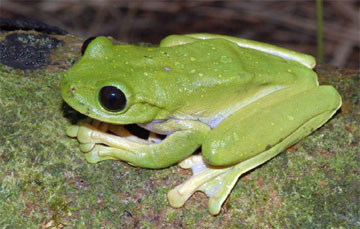 A large tree frog, Nyctimystes sp., with enormous eyes was found next to a clear running mountain river. Photo copyright Steve Richards. 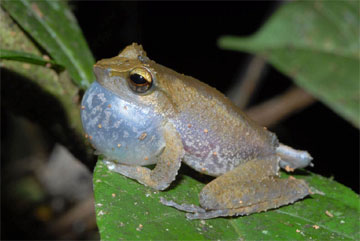 A frog, Litoria sp., believed to be new to science, and which uses a loud ringing song to call for a mate, was discovered in a rainforest during a Conservation International (CI) led Rapid Assessment Program (RAP) expedition of Papua New Guinea’s highlands wilderness in 2008. Photo copyright Steve Richards. 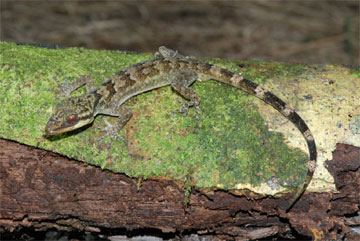 Bent-toed gecko, Cyrtodactylus sp., discovered in dense rainforest. Photo copyright Steve Richards. 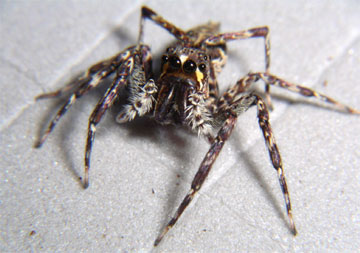 A jumping spider species new to science, Tabuina varirata, and from a genus new to science, was found on a conifer tree in a rainforest clearing during the CI-led Rapid Assessment Program expedition of Papua New Guinea. 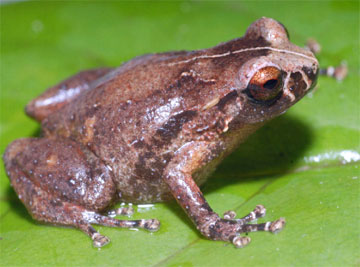 Tiny species with a sharp chirping call, Oreophryne sp., discovered in limestone hills. Photo copyright Wayne Maddison. 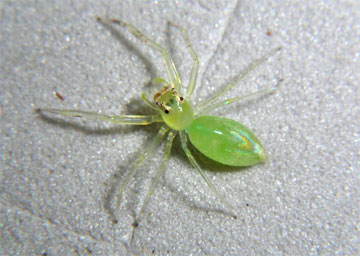 A jumping spider species potentially new to science, Orthrus sp., was found in a rainforest zone. Photo copyright Wayne Maddison. |
“The vast Kaijende Uplands and nearby valleys represent one of Papua New Guinea’s largest undeveloped highlands wilderness areas, and all of it is under the tenure of local clan landowners. These forests are essential to their traditional lifestyles,” said CI scientist Steve Richards, who led the expedition.
CI scientists were joined by researchers from Papua New Guinea, the University of British Columbia (UBC) and Montclair State University. The expedition also has an anthropological component — Montclair State University anthropologist Dr. William Thomas worked with the local Hewa clans to document the natural history and local knowledge of the Kaijende Uplands as part of the “Forest Stewards”, an initiative he started with Dr. Bruce Beehler of CI.
“Dr. Thomas has devoted his professional life to the study of the traditional knowledge system of the Hewa people. Their intimate knowledge of and stewardship over a large tract of this vast upland wilderness has led to conservation of their wildlife and environment. Dr. Thomas’s goal is to help the Hewa continue this indigenous stewardship into the next century, for the good of these people and the world at large,” said Beehler.
CI says local communities are dependent on the area for game, forest products, and provision of clean drinking water. The conservation group also notes that the ecosystem plays an important component in global climate, sequestering vast amounts of carbon.
CI says it plans three more expeditions to the Papua New Guinea this year. Earlier RAP surveys on the island of New Guinea turned up dozens of undocumented species.
New Guinea, split politically between the independent nation of Papua New Guinea and the Indonesian provinces of Papua and West Papua, is the world’s second largest island. It is home to extensive tropical forests and a rich diversity of cultures and wildlife.
The government of Papua New Guinea is leading a push to include forest conservation in the next global climate treaty. The the proposed mechanism — dubbed REDD for Reducing Emissions from Deforestation and forest Degradation — would compensate developing countries for preserving their forests. Deforestation and degradation currently accounts for nearly a fifth of greenhouse gas emissions from human activities, a share larger than all the world’s cars, trucks, planes and ships combined.
More at Ci’s discoveries site
Related articles
DR Congo, Indonesia, PNG, Tanzania, Vietnam win REDD funding for forest conservation
(03/20/2009)
The United Nation’s REDD Program has approved $18 million in support of forest conservation projects in five pilot countries: Democratic Republic of Congo, Indonesia, Papua New Guinea, Tanzania, and Viet Nam.

Papua New Guinea creates first nature reserve
(03/03/2009)
Home to numerous endemic species and some of the Asia’s last intact tropical forests, Papua New Guinea has created its first national conservation area. Unique in structure, the park is owned by 35 surrounding indigenous villages which have agreed unanimously to prohibit hunting, logging, mining, and other development within the park. The villages have also created a community organization that will oversee management of the park. The 10,000 villagers found partners in Wooland Park Zoo in Seattle, Conservation International, and National Geographic. The conservation organizations spent twelve years working with locals and the Papua New Guinea government to establish the YUS Conservation Area.

24% of Papua New Guinea’s rainforest destroyed or degraded by logging in 30 years
(02/23/2009)
Nearly one quarter of Papua New Guinea’s rainforests were damaged or destroyed between 1972 and 2002, report researchers writing in the journal Biotopica. The results, which were published in a report last June, show that Papua New Guinea is losing forests at a much faster rate than previously believed. Over the 30-year study period 15 percent of Papua New Guinea’s tropical forests were cleared and 8.8 percent were degraded through logging.
How activists and scientists saved a rainforest island from destruction for palm oil
(02/12/2008)
In mid-January, Mongabay learned that the government of Papua New Guinea had changed its mind: it would no longer allow Vitroplant Ltd. to deforest 70% of Woodlark Island for palm oil plantations. This change came about after one hundred Woodlark Islanders (out of a population of 6,000) traveled to Alotau, the capital of Milne Bay Province, to deliver a protest letter to the local government; after several articles in Mongabay and Pacific Magazine highlighted the plight of the island; after Eco-Internet held a campaign in which approximately three thousand individuals worldwide sent nearly 50,000 letters to local officials; and after an article appeared in the London Telegraph stating that due to deforestation on New Britain Island and planned deforestation on Woodlark Island, Papua New Guinea had gone from being an eco-hero to an ‘eco-zero’.
New species discovered in New Guinea
(02/07/2006)
A team of scientists led by conservation International (CI) found dozens of new species in a survey of New Guinea’s Foja Mountains. The December 2005 trip by a team of U.S., Indonesian, and Australian scientists discovered new species of frogs, butterflies, plants, and an orange-faced honeyeater, the first new bird from the island of New Guinea in more than 60 years.